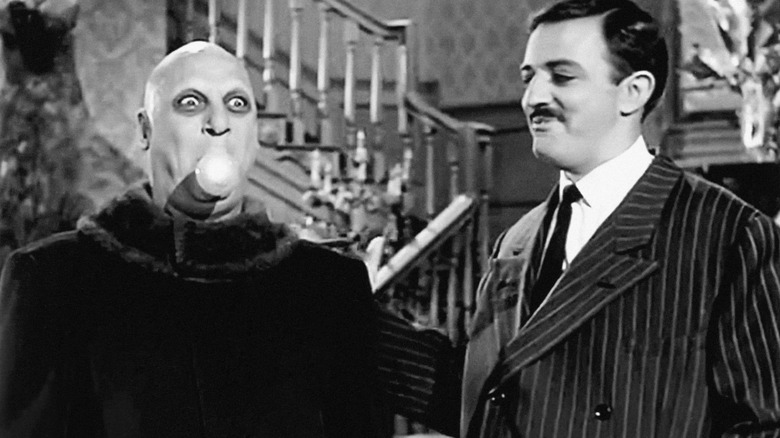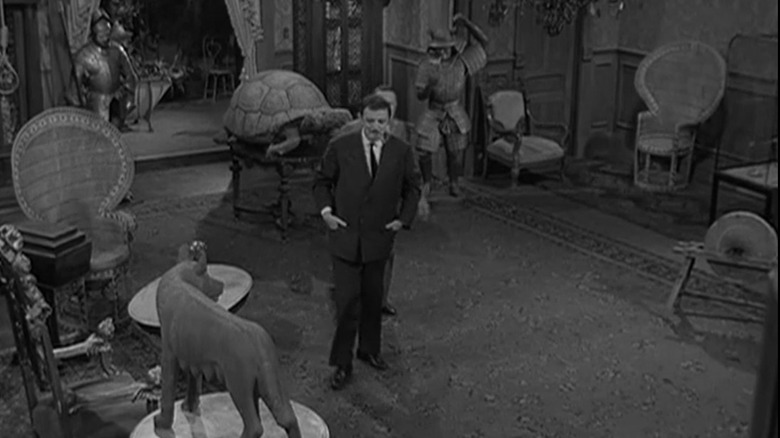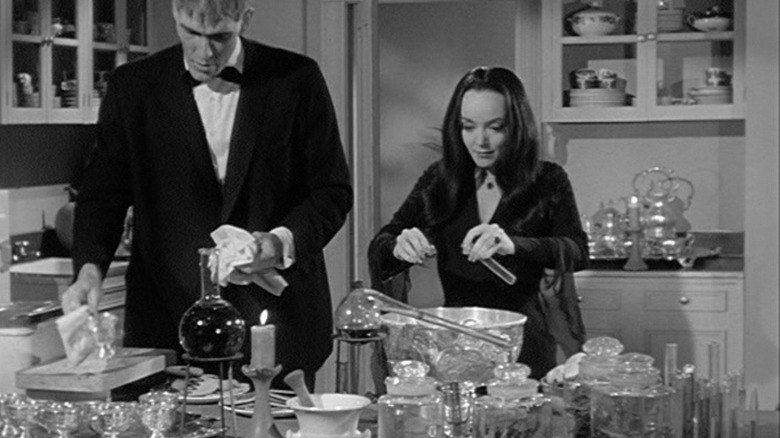Bringing The Addams Family To TV Took Some Quick Thinking With The Set Design
As detailed in Linda H. Davis' 2021 biography "Charles Addams: A Cartoonist's Life," the longtime illustrator for the New Yorker, famous for his ghastly, grim sense of humor, suffered a heart attack in 1988 while sitting in his own parked car. Addams' widow, Marilyn "Tee" Miller, pointed out shortly thereafter that her husband had always been a car enthusiast and that the location of his death was perfectly fitting. While Addams did have a ghoulish sensibility and a passion for the macabre — he and Miller married in a pet cemetery — he was, by all accounts, a gentle and silly man who looked more like a journalist than a mortician. Although he did have a coffee table that had been converted from an old embalming table.
From Addams' hand came a glorious miasma of death and gallows humor that graced the pages of his publication from his first published strip in 1937 until his death 50 years later. Addams became best known for a recurring family of characters that seemed to live in a universe with sensibilities completely opposite our own. Addams' family took delight in dark and stormy days, cultivated rose thorns (sans roses), and — in what might be Addams' most famous strip — merrily murdered Christmas carolers with a cauldron of boiling oil. The family consisted of a squat, troll-like father, a gaunt and cadaverous mother, a wide-eyed bald weirdo who laughed during horror movies, two dreadful children — a vicious twerp and a sullen goth — a witch-like grandmother, and a Frankenstein butler. They also had a cousin covered in hair who would sometimes visit, as well as a living severed human hand.
Before long, these characters took on the author's name and became the proper noun version of the Addams Family.
Adaptation for TV
By 1964, the Addams Family had become so popular that MGM optioned the characters for a grim TV sitcom, which presented a new host of creative hurdles. For one, the Addams Family now needed names. Charles Addams had already settled on the name Gomez for the father and Morticia for the mother, but it took a while for him to name the kids. According to a report in the A.V. Club, Wednesday Addams was named by a friend of Charles' named Joan Blake after the famous "Monday's Child" poem.
Additionally, the Addams Family needed a home. In the comics, the Family lived in an enormous dilapidated mansion full of creaky boards and rotting walls. The look of the comics would't be accurately reproduced on screen until Barry Sonnenfeld's 1991 feature film adaptation of the characters. In 1964, something more practical was needed.
As it so happened, Addams lived in a large, posh, over-decorated apartment in Manhattan, and the production designers of the upcoming sitcom decided that would have to be the look they would go with. It would have been far too cost prohibitive to build new sets, so MGM hastily redressed the sets that had been left over from the 1964 film "The Unsinkable Molly Brown" that had just wrapped shooting. Luckily for the Addams Family, they would be blessed with a home large enough for a feature film.
Then MGM, without much sense of rhyme or reason, began plundering their own prop warehouses looking for something — for anything — that would be considered remotely "haunted." They scattered the set with stuffed tortoises, sharpening stones, anything weird. If it was creepy, kooky, mysterious, or spooky, it was included.
A sitcom, but evil
The sets for "The Addams Family" are unique as sitcoms go. The classic monster movie image of the overgrown "haunted mansion" was reserved for "The Munsters," a monstrous "Addams" rival. In contrast, the Addams lived like Old Money, residing in a very nice home that was ... a little off. One could seem themselves resting in some of the Addams' living spaces, provided they weren't shocked by the severed hands or the hair monsters living up the chimney.
Rob Zombie, the director of the new feature film based on "The Munsters," once recorded a commentary track for "Munster Go Home," wherein he made a vital distinction between the two monstrous families that ruled the airwaves in 1964. He said that "the Munsters were people who look like monsters, and the Addams family were monsters who look like people." The Munsters were gentle and kind and only ran into static from their neighbors due to the way they look. One might see "The Munsters" as a metaphor for gentrification or even the immigrant experience. Can monsters assimilate? "The Addams Family," in contrast, were not gentle and didn't care to assimilate. They had found their niche far on the outskirts of humanity, embracing and enjoying sex and death. The Munsters were lovable lummoxes. The Addams Family would bury you alive as soon as look at you, and smile all the while.
As such, the design of the Addams home did have a dramatic function. Like the Addams themselves, it looked relatively normal, but it came from a parallel dimension that was ever so mildly askew. That skewed sensibility was the very heart of Charles Addams.


